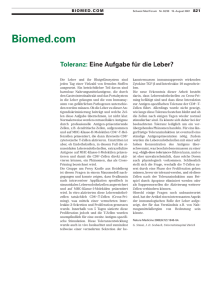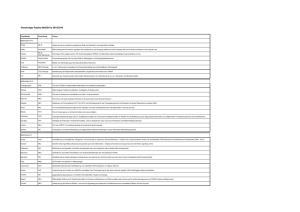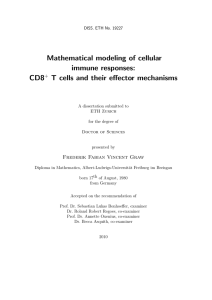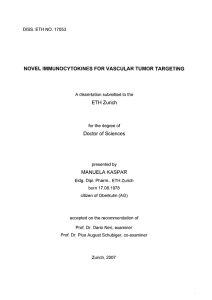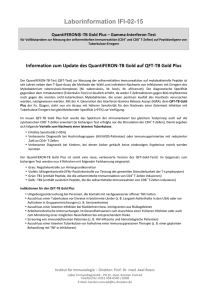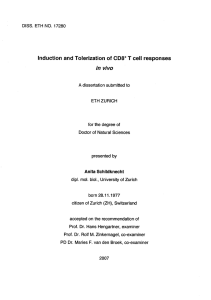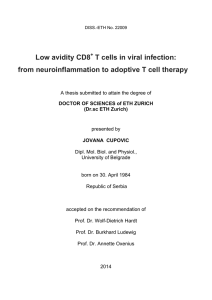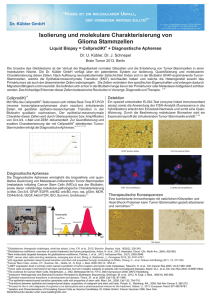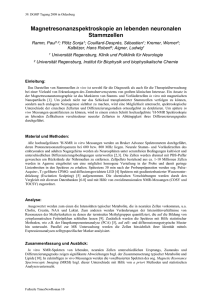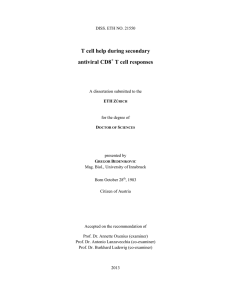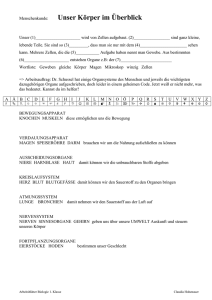The Role of the Adaptor Protein ADAP in different T cell subsets and
Werbung
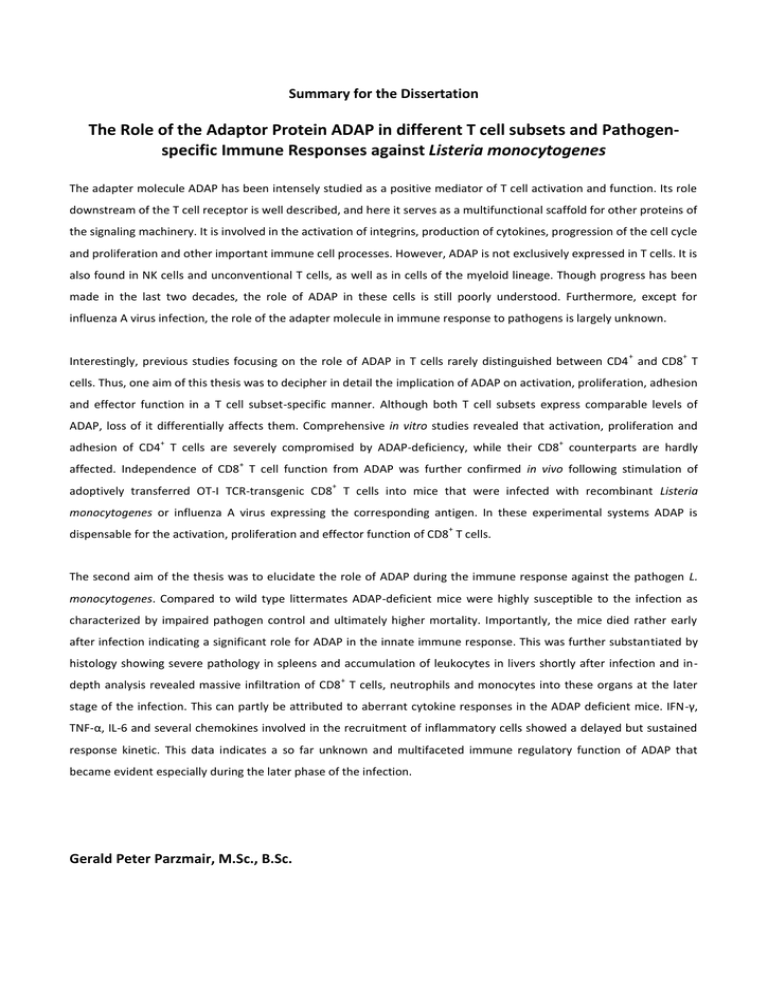
Summary for the Dissertation The Role of the Adaptor Protein ADAP in different T cell subsets and Pathogenspecific Immune Responses against Listeria monocytogenes The adapter molecule ADAP has been intensely studied as a positive mediator of T cell activation and function. Its role downstream of the T cell receptor is well described, and here it serves as a multifunctional scaffold for other proteins of the signaling machinery. It is involved in the activation of integrins, production of cytokines, progression of the cell cycle and proliferation and other important immune cell processes. However, ADAP is not exclusively expressed in T cells. It is also found in NK cells and unconventional T cells, as well as in cells of the myeloid lineage. Though progress has been made in the last two decades, the role of ADAP in these cells is still poorly understood. Furthermore, except for influenza A virus infection, the role of the adapter molecule in immune response to pathogens is largely unknown. + + Interestingly, previous studies focusing on the role of ADAP in T cells rarely distinguished between CD4 and CD8 T cells. Thus, one aim of this thesis was to decipher in detail the implication of ADAP on activation, proliferation, adhesion and effector function in a T cell subset-specific manner. Although both T cell subsets express comparable levels of ADAP, loss of it differentially affects them. Comprehensive in vitro studies revealed that activation, proliferation and + + adhesion of CD4 T cells are severely compromised by ADAP-deficiency, while their CD8 counterparts are hardly + affected. Independence of CD8 T cell function from ADAP was further confirmed in vivo following stimulation of + adoptively transferred OT-I TCR-transgenic CD8 T cells into mice that were infected with recombinant Listeria monocytogenes or influenza A virus expressing the corresponding antigen. In these experimental systems ADAP is + dispensable for the activation, proliferation and effector function of CD8 T cells. The second aim of the thesis was to elucidate the role of ADAP during the immune response against the pathogen L. monocytogenes. Compared to wild type littermates ADAP-deficient mice were highly susceptible to the infection as characterized by impaired pathogen control and ultimately higher mortality. Importantly, the mice died rather early after infection indicating a significant role for ADAP in the innate immune response. This was further substantiated by histology showing severe pathology in spleens and accumulation of leukocytes in livers shortly after infection and in+ depth analysis revealed massive infiltration of CD8 T cells, neutrophils and monocytes into these organs at the later stage of the infection. This can partly be attributed to aberrant cytokine responses in the ADAP deficient mice. IFNTNF- IL-6 and several chemokines involved in the recruitment of inflammatory cells showed a delayed but sustained response kinetic. This data indicates a so far unknown and multifaceted immune regulatory function of ADAP that became evident especially during the later phase of the infection. Gerald Peter Parzmair, M.Sc., B.Sc. Zusammenfassung für die Dissertation The Role of the Adaptor Protein ADAP in different T cell Subsets and Pathogen-specific Immune Responses against Listeria monocytogenes Das Adaptorprotein ADAP wurde als positiver Regulator in T Zellen identifiziert und weitreichende Untersuchungen in den letzten zwei Jahrzenten haben seine Bedeutung für die Aktivierung und Funktion dieser Zellen belegt. Als multifunktionales Molekül ist es an der Transduktion von Signalen des T Zell Rezeptors beteiligt und funktionell in die Integrinaktivierung, Zytokinsynthese, Zellzyklusprogression und Proliferation, sowie weiterer wichtiger Immunzellprozessen involviert. ADAP wird nicht ausschließlich in T Zellen exprimiert, sondern findet sich auch in NK Zellen, unkonventionellen T Zellen und Zellen des myeloiden Zweigs. Derzeit gibt es jedoch wenige publizierte Daten zur Rolle von ADAP in diesen Zellen und die immunologischen Funktionen des Adapterproteins im Kontext von Infektionen ist mit der Ausnahme der Influenza A Virus Infektion bislang nicht untersucht worden. Während es umfassende publizierte Daten zur Funktion von ADAP in T-Zellen gibt, wurde bei den bisher + + publizierten Studien in der Regel nicht zwischen CD4 und CD8 T Zellen differenziert. Ein Ziel dieser Arbeit war es zu klären, welche Rolle ADAP für die Aktivierung, Proliferation, Adhesion und das Ausüben von Effektorfunktionen in CD4 + und CD8 + T-Zellsubpopulationen hat. Obwohl beide Zelltypen ADAP in vergleichbaren Mengen exprimieren, hat der Verlust des Proteins unterschiedliche Konsequenzen. So war die + Aktivierung, Proliferation und Adhäsion von ADAP-defizienten CD4 T Zellen in vitro stark beeinträchtigt, + während nur geringe Effekte bei CD8 T Zellen erkennbar waren. Diese Ergebnisse wurden im Rahmen + adaptiver Transferexperimente bestätigt, bei denen OT-I TCR-transgene CD8 T Zellen nach Transfer in Mäuse, die mit rekombinanten Listeria monocytogenes oder Influenza A Virus infiziert waren, aktiviert wurden. In Übereinstimmung mit den zuvor gewonnenen in vitro Daten ergaben auch diese Untersuchungen dass ADAP + für die Aktivierung, Proliferation und Effektorfunktion von CD8 T-Zellen nicht essentiell ist. Die zweite Frage, die im Rahmen dieser Arbeit adressiert wurde ist, welche Funktionen ADAP bei der Immunantwort gegen das Pathogen L. monocytogenes spielt. In vivo Infektionsexperimente ergaben, dass ADAP-defiziente Mäuse im Vergleich zu Wildtyp-Tieren deutlich anfälliger für die Infektion sind, welches sich in einer verminderten Erregerkontrolle und erhöhten Mortalität widerspiegelte. Interessanterweise starben die Tiere sehr früh nach der Infektion, was auf eine bedeutende Rolle für ADAP in der angeborenen Immunantwort gegen das Bakterium schließen lässt. Diese Annahme wurde durch histologische Befunde bestätigt, die früh nach Infektion eine massive Pathologie in der Milz und verstärkte Infiltration von Leukozyten in die Leber dokumentierten. Eingehendere Untersuchen zeigten darüber hinaus eine übermäßige Einwanderung von CD8 + T Zellen, Neutrophilen und Monozyten in die Organe zu späteren Zeitpunkten der Infektion, die teilweise durch veränderte Zytokin- und Chemokinantworten erklärt werden kann. So waren initial geringere Konzentrationen von IFN- TNF- IL-6 und einschlägiger, an der Rekrutierung von Immunzellen beteiligter, Chemokine in ADAP- defizienten Mäusen messbar, jedoch waren diese Mediatoren insgesamt für einen längeren Zeitraum nach 1 Infektion im Serum der Tiere zu detektieren. Diese Daten weisen deutlich auf eine bislang wenig beschriebene immunregulatorische Funktion von ADAP hin, die insbesondere in der späteren Phase der Infektion deutlich wird. Gerald Peter Parzmair, M.Sc., B.Sc. 2
